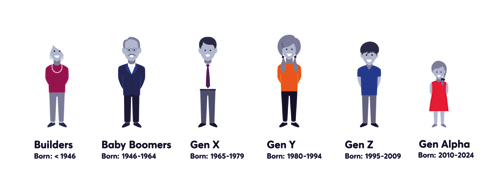Generations by birth year
View(s):(Birth year and associated classifications for segmentation)
Branding process begins with the STP of which the first step is Segmentation which involves stratifying the market into different clusters based on similarities or commonalities. The idea is to identify or analsye similar behaviours of each segment so that the marketer can use his strategies in targeting and positioning. Segmentation is based on either, demographic, psychographic or behavioral factors of the consumers. Gender and age are two main demographic factors which are analysed in this exercise. However, in addition to the age, marketers also look at the generation that the consumer belongs to as it signifies certain behavioral patterns pertaining to each cluster or strata. Even though demographic segmentation is fading away as an important measurement of analysing consumer behavior, the tendency of analysing the generation the consumer belongs to is always considered important.
 Here’s a list of all generations/age groups and their names
Here’s a list of all generations/age groups and their names
based on birth year:
- The Greatest Generation:
born 1901 to 1924
- The Silent Generation: born
1928 to 1945
- Baby Boomers: born 1946 to 1964
- Generation Jones: born
1955 to 1965
- Generation X: born 1965 to 1980
- Xennials: born 1977 to 1983
- Millennials: born 1981 to 1996
nGeneration Z: born 1997 to 2010
- Generation Alpha:
born after 2011
- The Greatest Generation: born 1901 to 1924
The Greatest Generation refers to the cohort of individuals who grew up during the Great Depression and went on to fight in World War II. This term was coined by journalist Tom Brokaw in his book “The Greatest Generation,” published in 1998, to honor and recognize the resilience and achievements of this generation. The world has still not gone through what they have gone through to know how hard life could be.
Famous representatives: John F. Kennedy (born 1917), Rosa Parks (born 1913), Bob Dole (born 1923).
The Silent Generation:
born 1928 to 1945
The Silent Generation, also known as the Traditionalists or the Lucky Few, refers to the cohort of individuals born between 1928 and 1945. This generation came after the Greatest Generation and before the Baby Boomers. The term “silent” is often associated with the perception that this generation was relatively less vocal or assertive compared to others. Famous representatives: Martin Luther King Jr (born 1929), Elvis Presley (born 1935), Bob Dylan (born 1941). However, the given names are not the ones who have been so silent. They have been vocal and outspoken at times. But this generation was able to experience the benefits of social transformations that took place after the industrial revolution etc.
Baby Boomers: born
1946 to 1964
The Baby Boomer generation began immediately after World War II (with people born in 1946) and wrapped up in 1964. After the World War II, there was a boom in babies as the world lost a considerable number of human lives, the remaining ones, procreated rapidly. The term Baby Boomers coined due to this reason. The generation that has not seen the worst but has seen enough to know how the world has transformed from what it was to what it is today. They also hold strong opinions on matters and are hard to change. (Due to this reason, they may also be known as ‘hard-nuts’).
Famous boomers: Bill Clinton (born 1946), George W. Bush (born 1946), Donald J. Trump (born 1946) Tony Blair (born 1953), Oprah Winfrey (born 1954).
Generation Jones: born
1955 to 1965
Younger boomers — titled Generation Jones to reflect “keeping up with the Joneses” culture, the slang term “jones” for desire, the confusion of Bob Dylan’s Mr. Jones, and just the generic anonymity of the Jones name — were born between 1955 and 1965.
Famous jonesers: Bill Gates (born 1955), Steve Jobs (born 1955), Barak Obama (born 1961). Revolutionary thinkers and controllers of the wealth of the world. They set agendas and pushed them through to younger generations to follow.
 Generation X: born 1965 to 1980
Generation X: born 1965 to 1980
With a decline in birth rates in 1965 came Generation X, which demographers generally say lasted until 1980. Gen X is also called the “baby bust” because of its smaller post-boom numbers. This generation has held key positions in organisations and are continuing to thrive. They have seen the world enough to know what can happen next. This generation also controls a considerable portion of the wealth of the world.
Famous gen xers: Elon Musk (born 1971), Larry Page (born 1973), Jack Dorsey (born 1976).
Xennials: born 1977 to 1983
Squeezed in next was a “micro-generation” of Xennials born in the late ’70s and early ’80s. Also known as the “Oregon Trail generation,” Xennials had an analog childhood and a digital adulthood. In the Sri Lankan context, these are the people who used to play on the road, used to run behind kites in play grounds and paddy fields, used to catch fish in the white water and suddenly embraced floppy disks and computers, and started playing video games and computer games and ended up absorbing technology as much as they could. They are more of a hybrid generation between the one before them and the one after them. Due to this, they also have the ability to understand individuals from many age categories and work in harmony with many generations.
Millennials: born 1981 to 1996
According to Pew Research Center, Millennials were born between 1981 and 1996. The older segment of the demographic are well into adulthood. Millennials are also called Generation Y for following Generation X, and as the children of boomers, they’re sometimes called “echo-boomers”. The older segment of this generation is now in leading positions of most of the organizations as the generations before them find it difficult to cope up with technology to lead and generations after them find it difficult to deal with the former. Both in political and business world and even in educational institutes, they get into higher positions before their previous generations did as they have embraced technology without any hesitation.
 Generation Z: born 1997 to 2010
Generation Z: born 1997 to 2010
Then came Gen Z, or iGen, which roughly starts with people born in 1997. Generation Z kids are the first to be born into a world where there’s always a way to be constantly digitally connected to one another, either through smart phones, screens, and tablets. This generation will never experience a “teenage”. Instead, they will become “screen-agers”. Their entire childhood or most of it would be on screens and in fact when they are born, the lullabies will also not be sung instead will be played on the mobile handset or tab of their parents. Again, there is nothing right or wrong about it. Research also show that they are more health conscious and are not prone to consume alcohol as previous generations did.
Generation Alpha: born after 2011
What comes after Gen Z? Generation Alpha are the first to be born entirely in the 21st century. Most members are the children of gen xers or millennials. Gen Alpha kids are the first who will never know a time when social media didn’t exist. This generation would live with augmented realities. AI based creations will fulfill their whims and wishes. Probably they will fall in love with an AI created character that they come across in their digital world. They would be talking to AI based apps when they are alone. They wouldn’t take half the time taken by previous generations to learn about this world. They will be equipped with ways and means of getting things done faster and easier.
Some generations enjoy the moment – cherish memories later… some generations share it with their loved ones… some generations save it in their devices to share later on social media… some generations try to have their face also in the capture to tell the world that they were also a part of it… Some generations wouldn’t go there at all… they will watch it on a screen if they really must watch.
Implications for Marketers
A 25-year-old assistant marketing manager was asked to design a press advertisement for a new product intended for Millennials. After conducting interviews with a sample of potential customers, she produced a beautiful ad with an eye-catching graphic and a one-line copy, followed by a website link as a “call-to-action”. What she did not anticipate was that her 50-year-old marketing manager would complain about the lack of details on product features, advantages, and benefits on that print. Thinking that her manager did not understand the minimalistic marketing approach to Millennials, she quit her job—ironically confirming her manager’s beliefs that younger staff could not accept criticism.
Today, this generational misalignment is happening in many organisations. Marketers around the world are facing the challenge of serving five different generations: Baby Boomers, Generation X, Generation Y, Generation Z, and Generation Alpha. The first four of these generations make up the workforce. The majority of Baby Boomers are still in the workforce. However, Generation X now holds most of the leadership roles globally. Generation Y is now the largest in the workforce, while Generation Z is the newest entrants. These generations have different levels of tech-savviness.
Therefore, it’s evident that marketers must take care of two audiences.
- The internal audience – the audience which would probably decide what the customers would want or with the belief that they know what customers want or the ones who anticipate what customers would want without knowing exactly what they would want.
- The external audience – they are the actual buyers and consumers. The marketers today should know how to address the needs of a mix of many generations in one marketing message which is a tough task.
This is where the EQ or even SQ play a vital role than IQ or the technical knowledge of marketing. You may know what’s technically right but practically getting the idea across to your internal audience which consists of many generations wouldn’t be an easy task. After all, challenges are all for marketers to win.
HitAd.lk is the best and biggest mobile phone market in Sri Lanka, and we guarantee you will find what you need here from our extensive listing of mobile phones for sale in Sri Lanka. Whether it’s a budget-priced smartphone for communication, or higher end features with advanced connectivity, there are many different options from which to choose from on our site!


